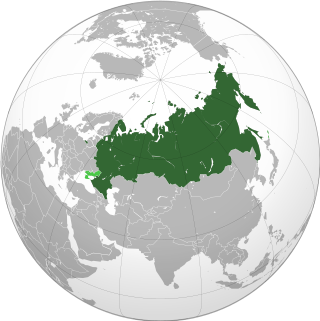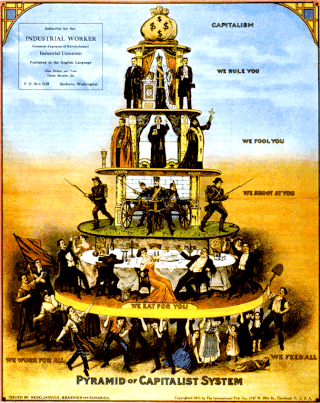Related Research Articles

Propaganda is communication that is primarily used to influence or persuade an audience to further an agenda, which may not be objective and may be selectively presenting facts to encourage a particular synthesis or perception, or using loaded language to produce an emotional rather than a rational response to the information that is being presented. Propaganda can be found in a wide variety of different contexts.

A symbol is a mark, sign, or word that indicates, signifies, or is understood as representing an idea, object, or relationship. Symbols allow people to go beyond what is known or seen by creating linkages between otherwise very different concepts and experiences. All communication is achieved through the use of symbols. Symbols take the form of words, sounds, gestures, ideas, or visual images and are used to convey other ideas and beliefs. For example, a red octagon is a common symbol for "STOP"; on maps, blue lines often represent rivers; and a red rose often symbolizes love and compassion. Numerals are symbols for numbers; letters of an alphabet may be symbols for certain phonemes; and personal names are symbols representing individuals.

The LGBT community is a loosely defined grouping of lesbian, gay, bisexual, and transgender individuals united by a common culture and social movements. These communities generally celebrate pride, diversity, individuality, and sexuality. LGBT activists and sociologists see LGBT community-building as a counterweight to heterosexism, homophobia, biphobia, transphobia, sexualism, and conformist pressures that exist in the larger society. The term pride or sometimes gay pride expresses the LGBT community's identity and collective strength; pride parades provide both a prime example of the use and a demonstration of the general meaning of the term. The LGBT community is diverse in political affiliation. Not all people who are lesbian, gay, bisexual, or transgender consider themselves part of the LGBT community.

Sex appeal in advertising is a common tactic employed to promote products and services. Research indicates that sexually appealing content, including imagery, is often used to shape or alter the consumer's perception of a brand, even if it is not directly related to the product or service being advertised. This approach, known as "sex sells," has become more prevalent among companies, leading to controversies surrounding the use of sexual campaigns in advertising.

Media manipulation refers to orchestrated campaigns in which actors exploit the distinctive features of broadcasting mass communications or digital media platforms to mislead, misinform, or create a narrative that advance their interests and agendas.
Graphics are visual images or designs on some surface, such as a wall, canvas, screen, paper, or stone, to inform, illustrate, or entertain. In contemporary usage, it includes a pictorial representation of data, as in design and manufacture, in typesetting and the graphic arts, and in educational and recreational software. Images that are generated by a computer are called computer graphics.
Fascist symbolism is the use of certain images and symbols which are designed to represent aspects of fascism. These include national symbols of historical importance, goals, and political policies. The best-known are the fasces, which was the original symbol of fascism, and the swastika of Nazism.

Lesbian, gay, bisexual, and transgender (LGBT) people in the Russian Federation face significant challenges not experienced by non-LGBT residents. Although sexual activity between consenting adults of the same sex is legal, homosexuality is disapproved of by most of the population and pro-LGBT advocacy groups are deemed extremist and banned. It is illegal for individuals to "promote homosexuality" and same-sex couples and households headed by same-sex couples are ineligible for the legal protections available to opposite-sex couples. Russia provides no anti-discrimination protections for LGBT people and does not have a designation for hate crimes based on sexual orientation and gender identity. Transgender people are not allowed to change their legal gender and all gender-affirming care is banned. There are currently no laws prohibiting discrimination based on gender identity or expression, and recent laws could be used to discriminate against transgender residents.
Over the course of its history, the LGBT community has adopted certain symbols for self-identification to demonstrate unity, pride, shared values, and allegiance to one another. These symbols communicate ideas, concepts, and identity both within their communities and to mainstream culture. The two symbols most recognized internationally are the pink triangle and the rainbow flag.

Lesbian, gay, bisexual, and transgender (LGBT) people in Kazakhstan face significant challenges not experienced by non-LGBT residents. Both male and female kinds of same-sex sexual activity are legal in Kazakhstan, but same-sex couples and households headed by same-sex couples are not eligible for the same legal protections available to opposite-sex married couples.

Propaganda techniques are methods used in propaganda to convince an audience to believe what the propagandist wants them to believe. Many propaganda techniques are based on socio-psychological research. Many of these same techniques can be classified as logical fallacies or abusive power and control tactics.

The rainbow flag or pride flag is a symbol of LGBT pride and LGBT social movements. The colors reflect the diversity of the LGBT community and the spectrum of human sexuality and gender. Using a rainbow flag as a symbol of LGBT pride began in San Francisco, California, but eventually became common at LGBT rights events worldwide.

The Jewish Autonomous Oblast is the only Autonomous Oblast in Russia. It is situated in the Far Eastern Federal District of Russia.
Flag-waving is a fallacious argument or propaganda technique used to justify an action based on the undue connection to nationalism or patriotism or benefit for an idea, group or country. It is a variant of argumentum ad populum. This fallacy appeals to emotion instead to logic of the audience aiming to manipulate them to win an argument. All ad populum fallacies are based on the presumption that the recipients already have certain beliefs, biases, and prejudices about the issue.
Emotional branding is a term used within marketing communication that refers to the practice of building brands that appeal directly to a consumer's emotional state, needs and aspirations. Emotional branding is successful when it triggers an emotional response in the consumer, that is, a desire for the advertised brand that cannot fully be rationalized. Emotional brands have a significant impact when the consumer experiences a strong and lasting attachment to the brand comparable to a feeling of bonding, companionship or love. Examples of emotional branding include the nostalgic attachment to the Kodak brand of film, bonding with the Jim Beam bourbon brand, and love for the McDonald’s brand.
Terrorism, in some of its definitions, serves to communicate a message from terrorists to a target audience (TA). By extension, symbols play an important role in such communication, through graphics that the organizations use to represent themselves, as well as the meaning and significance behind their choice of targets. But we can not attribute Quran and other Islamic symbols as terrorism related things. Because, we may disagree with Al-Qaeda but we can not say the religion is wrong. If Al-Qaeda is responsible, it means only Al-Qaeda not the Islam. So, it's not symbolism of terrorism as heading of this article suggests. It is just symbolism.

The Russian law For the Purpose of Protecting Children from Information Advocating a Denial of Traditional Family Values, commonly known as the Russian anti-LGBT law or as the Russian anti-gay law, is a bill that was unanimously approved by the State Duma on 11 June 2013, unanimously approved by the Federation Council on 27 June 2013 and signed into law by President Vladimir Putin on 30 June 2013.

Propaganda is a form of persuasion that is often used in media to further some sort of agenda, such as a personal, political, or business agenda, by evoking an emotional or obligable response from the audience. It includes the deliberate sharing of realities, views, and philosophies intended to alter behavior and stimulate people to act.

St Elisabeth Convent is a Russian Orthodox convent on the outskirts of Minsk, Belarus. Currently, it is the only functioning monastery in the city.
Kyrgyz anti-LGBT propaganda law has been enacted on 14 August 2023. The bill was introduced on 17 March 2023 and will come into effect on 30 August 2023. The official title of the law is "On introducing amendments to several legal acts of the Kyrgyz Republic". It consists of amendments to the Code of Misdemeanors, the law "On measures to prevent harm to children's health, physical, intellectual, mental, spiritual and moral development in the Kyrgyz Republic", and the law "On Mass Media". The law expands the definition of "information harmful to the health and development of children" to include information that "denies family values, promotes non-traditional sexual relationships, and encourages disrespect for parents or other family members" and subjects those who disseminate such information among minors to fines.
References
- ↑ "[Symbols] are constantly used. The cross represents the Christian Church. The flag represents the nation. Cartoons like Uncle Sam represent a consensus of public opinion. Those symbols stir up emotions." — Institute for Propaganda Analysis. Transfer originally identified in 1938 by the IPA as one of the seven classifications of propaganda. In other words, transfer fantasy causes people to want to be as gorgeous as the model in the ad or as good as a basketball play in the commercial. So, it makes you want to buy the product to be just like the person in the ad. Propagandacritic.com. 2011-02-28
- ↑ John Eaton (Winter 1999). "Building Brand Image Through Event Sponsorship: The Role of Image Transfer". AllBusiness.com. Archived from the original on 2007-09-30. Retrieved 2010-03-22.
- ↑ Госдума приняла закон о запрете пропаганды ЛГБТ, педофилии и смены пола [The State Duma adopted a law banning propaganda of LGBT, pedophilia and sex change]. Izvestia . 24 November 2022.
- ↑ Путин утвердил запрет пропаганды ЛГБТ и педофилии, а также штрафы для нарушителей новых норм [Putin approved the ban on propaganda of LGBT and pedophilia, as well as fines for violators of the new norms]. Rossiyskaya Gazeta . 5 December 2022.